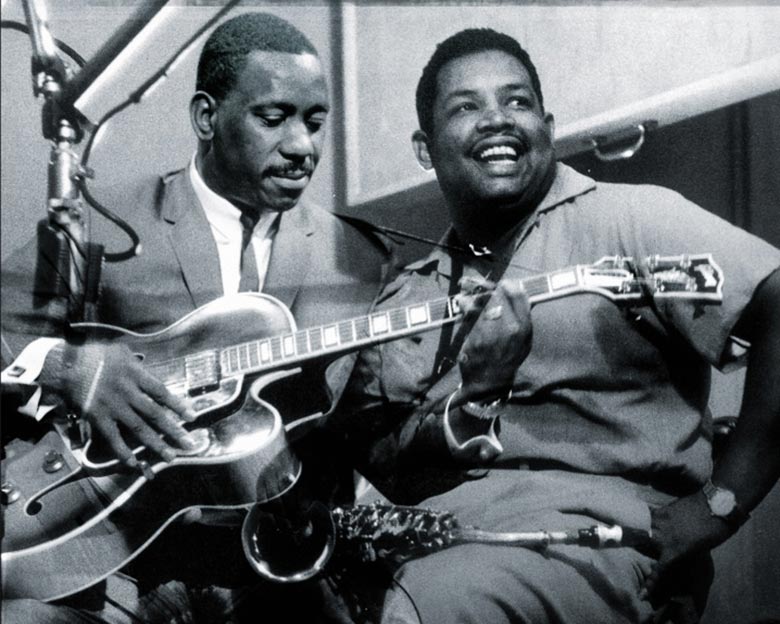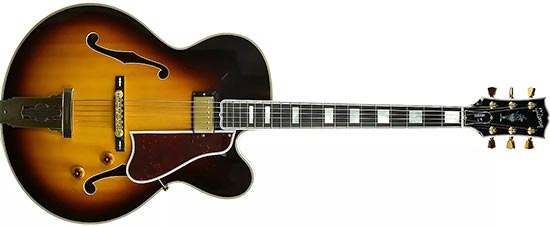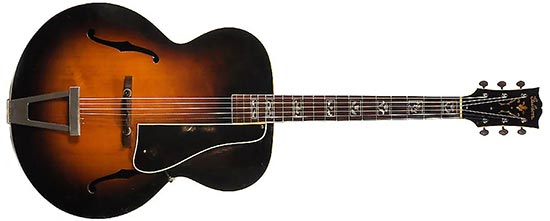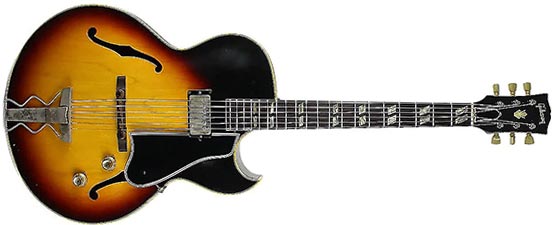Long before the advent of rock and roll, and high-speed shredding was a key part of any lead guitarist’s arsenal, there was jazz. Bold techniques, inspirational improvisation, and encyclopedic knowledge of music weren’t just desirable for post-war jazz musicians. They were a minimum requirement. Among the kings and key innovators in the genre was Wes Montgomery, whose groundbreaking technique and unique approach to the instrument influenced not only later jazz guitarists but globally, every six-string slinger. Among Montgomery’s acolytes are guitar legends, Jimi Hendrix, Eric Johnson, Steve Vai, and Stevie Ray Vaughan all citing him as a key influence on their playing.

It was when he heard Charlie Christian for the first time in 1943 that Wes Montgomery truly embraced the guitar, teaching himself to play the instrument while working as a welder. With no formal instruction, he played Indianapolis clubs by the age of twenty, copying Charlie Christian’s solos by night while working by day. When Lionel Hampton stopped by Indianapolis in 1948, he needed a guitar player, and Wes Montgomery joined him on the road.
Wes Montgomery played among titans of the genre, including Charles Mingus, Milt Buckner, and Fats Navarro, while one quintessential work in his life, was his recorded sessions with Quincy Jones. Astonishingly, in the lean post-war years, Montgomery maintained his work as a welder by day in order to support his wife and seven children, playing by night at jazz clubs until the wee hours of the morning. Perhaps it was this hectic schedule that led to Montgomery’s early death, by a heart attack in 1968. He left behind a towering legacy of jazz guitar, particularly embodied by his unique, instantly recognizable approach to soloing.
Here, we’ll take a close look at the guitars and gear Wes Montgomery used throughout his storied, often under-discussed career.
What Guitar Did Wes Montgomery Play?
Wes Montgomery is best known for playing Gibson L5 model guitars, as well as a variety of other archtop models such as Gibson’s ES-175 and L7 models for some of his recordings.
See the full list of Wes Montgomery guitars and gear below.
Gibson L5


| Finish | Sunburst/Natural |
| Years Used | 1958 to 1963/ 1965 to 1968 |
With no room to argue, the most famously associated guitar to Wes Montgomery, the Gibson L-5. Montgomery famously said of his trademarked model “I got a standard box. I don’t ever want nothing special. Then if I drop my box, I can borrow somebody else’s.” The “box” he was referring to, of course, was Gibson’s landmark jazz guitar, the single-cutaway variation on the L5 hollow body.
Gibson’s L5 was first introduced to the market almost a century ago, in 1923. It was initially offered as an acoustic instrument and was considered the benchmark against which all other big-band guitars were measured. Initial variations on this guitar lacked the sole Venetian cutaway that Wes Montgomery preferred, instead, basing their design on the cello.
It was the first guitar to feature F-holes rather than a standard round soundhole of most acoustic six-strings. This allowed the guitar to amplify and project the acoustic vibration of strings throughout the carved and tuned woods, using these F-holes as the projection points. Early models featured a 16” lower bout width, but in the 1930s this was increased to 17”, which was quickly followed by an 18” bout in the mid-30s. Although pre-war L5 models were all acoustic, it was the later electrified versions that Wes used for his career.
For the first time, in 1951, the L5 was given a pair of P90 pickups, allowing the guitar’s distinctive voice to be heard even over the loudest big bands. As the decade progressed, Gibson designated the L5-CES, standing for “Cutaway Electric Spanish”. It was this iteration of the guitar, with P90s and sole cutaway, that Wes Montgomery played at first.
The electric L5 represented, at the time, the pinnacle of Gibson’s archtop handcraft. With its acoustic-inspired spruce top, maple back and sides and deep, intricately carved body, the L5’s construction is key to its characteristically woody guitar tone. The L5’s neck is made from maple and walnut, with an ebony fretboard adorned with pearl block inlays and multi-ply binding.
Accordingly, Wes was playing an L5 with P90s in a Sunburst finish for the “Boss Guitar” album. However, as technology improved, so too did the pickup configuration on the L5, as Montgomery soon learned. Around the recording of Full House, Wes was playing an L5 in a natural finish, equipped with twin Gibson PAF humbuckers.
Sometime around 1965, Montgomery acquired yet another updated L5. This time, it came with a Florentine cutaway, a sharper, steeper affair that allowed improved upper-fret access. This increased playability benefited Montgomery’s octave-based approach to improvisation and allowed him to play further up the neck with greater ease. This guitar, with a sunburst finish and twin humbuckers, appeared on the cover of Montgomery’s live album Live at the BBC Studios 1965.
Jazzman George Benson purchased this guitar following Montgomery’s death and later passed it on to Wes Montgomery superfan (and yet another jazzman) Pat Metheny.
The most unique of Montgomery’s Gibson L5s was equipped with a solitary Gibson humbucker in the neck position. Supposedly, Gibson did not make a version of this guitar with a single pickup, so he had them custom-make the instrument for him. This guitar also featured the Venetian cutaway, in a Sunburst finish, and a heart-shaped inlay on the guitar’s body with Wes’s name inscribed in it. Supposedly, the name inlay was added to the guitar to cover up holes made by Wes’ fingers wearing against the wood. Sadly, this guitar was damaged in a fire sometime later but was restored at the Gibson Custom Shop by master luthier Mike McGuire. Montgomery played this guitar, as well as its twin-pickup sibling, from at least 1965 to the day he died in 1968. It can be seen, with the name inlay prominently displayed, on the back cover of Wes’ “Tequila Album”.
His final L5 was similar to this latter one, with the same spruce-and-maple body, walnut-and-maple neck, ebony fretboard, and solitary PAF humbucker. However, instead of the name inlay on its body, this guitar featured instead a sticker with Wes’ name on it. It also used the softer Venetian cutaway rather than the sharp Florentine style, perhaps a later-period attempt on Montgomery’s part to return to the sound of his earlier career.
The guitars Gibson built for Wes personally also featured metal tune-o-matic bridges instead of the traditional rosewood bridges of earlier L5 models. This addition, supposedly, was to help brighten his guitar tone, as was the choice to reverse the sole pickup in the neck position.
After his untimely death in 1968, Gibson released a signature model L5 based on his single-pickup sunburst guitars. Gibson briefly added this to their production line in the 1960s, albeit without naming it a “Wes Montgomery signature”, simply selling the guitar as a single-pickup variation on their classic L5. Although Wes Montgomery did not play the modern iteration of his signature guitar, it claims to be a faithful recreation of his single-pickup L5. The largest difference is its sole 57 classic pickup, which is a reproduction of the PAF pickups Gibson used in the era. PAF pickups were notoriously inconsistent, with subtle variations in coil winding from one pickup to the next, and often within a single pickup.
Gibson L7

| Finish | Sunburst |
| Years Used | 1959 |
Before he started playing his iconic L5, Montgomery briefly recorded with another Gibson archtop, the L7. During the recordings of the Wes Montgomery Trio, in 1959, Wes needed a professional six-string to record on. Fortunately, his friend Kenny Burrell owned an L7, which he lent to Montgomery for the recording of this album along with a Fender Deluxe amplifier.
The Gibson L7, like the L5, was initially marketed as an acoustic archtop, but Wes enjoyed the increased volume and dynamic response of the pickup-equipped electric version. It was built similarly to the L5, using a solid spruce top and maple back and sides, but with a rosewood fretboard rather than the L5’s ebony.
The L7 also lacks the cutaway that Wes Montgomery favored in his later career, instead this model was closely resembling to a cello. Its rosewood fretboard featured parallelogram inlays and it came stock with a black pickguard.
The L7 Wes Montgomery used featured a Charlie Christian pickup, a unique take on Gibson’s single-coil technology of the time. Named for the famed jazz guitarist Charlie Christian, this pickup featured huge clarity and warmth with plenty of power, particularly when compared to the other pickups available in 1959. By today’s standards, of course, it would be considered a low-output pickup, but the Charlie Christian-equipped L7 Wes Montgomery used had a fat, velvety sound.
This pickup used larger-than-average cobalt steel magnets, which held the pickup to the guitar in addition to holding the actual pickup together. Cobalt steel magnets of the time were particularly weak, and this lack of magnetic force was compensated for by the use of huge wire. It was wired with 38 gauge wires to increase power, and the result was often enough an astonishing low DC resistance of 1-4K ohms. These massive pickups added a whopping two pounds to the guitar’s weight, but the unique tone of the Charlie Christian speaks for itself.
Wes Montgomery often attempted to crank up the treble in his tone to compensate for the slightly muted, duller sound he achieved by playing strings with the side of his thumb. The Charlie Christian pickup’s distinctive tonal clarity worked well in this regard. However, when compared to later recordings of Montgomery’s playing, the increased treble response of the L5, as opposed to the L7, is palpable.
You can hear the warm, slightly fuzzy sound of this L7 in the 1959 recording of the album “A New Dynamic Sound”. Note the clarity of the higher notes, while the guitar’s tone retains all its breadth and warmth regardless of pitch.
Gibson ES-175

| Finish | Sunburst |
| Years Used | 1957 to 1964 |
Wes Montgomery’s second in line model was Gibson’s ES-175, yet another big-bodied archtop with a single-cutaway.
The ES-175 featured a trapeze tailpiece, Gibson’s tune-o-matic bridge (as opposed to the rosewood bridge on his other Gibsons), and dual pickups. Unlike the L5 and L7, the ES-175 was always intended to be an electric guitar. Accordingly, it was built to different specifications, including a mahogany set neck, maple body, and either twin P90s or humbuckers.
1950s ES-175 models had considerable warmth and sustain. Atop this neck was a rosewood fretboard with block inlays. The guitar’s fully hollow body was topped with a black pickguard and had the sharper Florentine cutaway that Wes preferred in the early 60s.
The ES-175 was made with all-laminate (rather than solid carved wood) construction. The benefit of these materials in craft is its minimized feedback while maintaining an affordable price. Accordingly, the ES-175 often rivals its more expensive cousins for sound quality despite being a cheaper instrument. It may well be that the ES-175’s competitive pricing appealed to Wes Montgomery, who famously eschewed convention and preferred reliable working instruments.
Table Showing Each Guitar Wes Montgomery Played Throughout His Career
| Make | Model | Color/Finish | Years |
|---|---|---|---|
| Gibson | ES-175 | Sunburst | 1957 to 1964 |
| Gibson | L-5 | Sunburst/Natural | 1958 to 1963/1965 to 1968 |
| Gibson | L7 | Sunburst | 1959 |
Wes Montgomery Amps Overview
Wes Montgomery, like many of his jazz contemporaries, prioritized a high-fidelity clean tone above all else when it came to his choice of amps. Supposedly, Montgomery never found an amp that sounded just the way he wanted. He used a variety of Fender amps early in his career, including one borrowed from Kenny Burrell, but later on became loyal to Standel solid-state amps rather than the all-tube affairs that were becoming popular among pop and rock players. Above all else, Wes Montgomery prized a natural, clean sound that emphasized the unique side of his guitar playing. Accordingly, he rarely used pedals, instead running his L5 straight into the brighter channel of a clean amp, and only rarely deploying effects if they were a part of the amp itself.
Let’s take a look at a few of the amps Wes used to achieve this sound over the years.
Fender Amps
Like many other American guitarists looking for a squeaky-clean, warm tone, Wes Montgomery first turned to Fender. He used various Fender amps over the course of his career, including a Deluxe borrowed from Kenny Burrell, Fender Super Reverbs, and Fender Twin Reverbs. Montgomery, constantly hunting for ways to coax more treble from his guitar tone, relied heavily on these tube-powered combo amps early in his career.
Wes Montgomery’s first notable use of a Fender amplifier came when, along with his L7, he borrowed a Fender Deluxe from his friend Kenny Burrell to record with the Wes Montgomery organ trio. The Deluxe was a medium-powered amp built with small ensembles in mind, with only a sole twelve-inch speaker with which to throw its voice. The original Fender Deluxe is often referred to as a “Tweed” amp thanks to its light brown cotton twill covering, which looks like tweed.
The Deluxe, unlike the higher-powered Fender amps of the 1950s, lacked the clean headroom required for busy jazz clubs, and Wes Montgomery only used it in the studio. Curiously, the Deluxe, with two channels, allows the signal from one input socket to find its way into the other. This means players can modify their tone by fiddling with the opposite channel controls to the one they are using.
Wes Montgomery’s Deluxe, as used in 1959, featured a 5Y3-GT rectifier, 2 6V6-GT power tubes operating in push-pull mode, and a 12AY7 and a 12AX7 in the preamp supplying 15 watts of power to a sole 12-inch Jensen speaker.
In the 1960s, Montgomery started playing through Fender Twin amplifiers, equipped with two speakers rather than one. Montgomery likely used the late-50s and early-60s Fender Twin models, which boasted the impressive Concert Series Jensen P12-N Alnico V blue-dome loudspeakers. These were built to handle even the loudest players without becoming overdriven, but he rarely needed such high output. Regardless, he played Fender Twin amps equipped with four military-grade 5881 power tubes and 12AX7 preamp tubes. The sound was occasionally garnished with reverb, most likely from the built-in reverb units in Fender’s amplifiers of the era.
Pursuing the warmth and breadth of reverb for his performances, Wes Montgomery also enjoyed playing the Fender Super Reverb until he switched to Standel amps. The Super Reverb was introduced in 1963, not long after Montgomery’s legend was rising, designed with built-in reverb and tremolo effects.
Montgomery’s time with the Super Reverb predates the introduction of the “silverface” model in 1967, so it’s safe to say he exclusively used the “blackface” iteration of this legendary amp. The Fender Super Reverb is notable for its “scooped mids” tone which emphasizes the bass and treble frequencies of the amplifier.
This is most useful in a band setting without a singer, where midrange frequencies compete heavily with the band’s lead singer for sonic space. The Super Reverb, as used by Wes Montgomery, featured four 12AX7 tubes, two 12AT7 tubes, two 6L6 tubes, and a solitary 5AR4/GZ34 rectifier tube. It boasted two channels, “Normal” and “Vibrato”. Critical to Wes Montgomery’s personal tastes, these amps also came with a treble-boosting “Bright” switch, which added spank and brilliance to the amplifier’s tone.
This combo amp came with four built-in ten-inch speakers, usually Jensen, Oxford, or JBL models. Eventually, however, Wes Montgomery would eschew these Fender amplifiers for a small, humble combo built by Standel.
Standel Super Custom XV
Montgomery, never totally satisfied with his guitar tone, switched from Fender to Standel in 1965.
Although Fender was one of the biggest guitar gear brands in the world, Wes Montgomery wasn’t quite getting the sound he wanted out of their amplifiers. Supposedly, the closest he ever came to achieving the sound in his head was when using Standel’s diminutive solid-state combo amps.
Standel, a little-known amp company based in California, began life in 1953 as a side business for founder Bob Crooks’ radio and hi-fi repair. Wes Montgomery was arguably (and may still well be) their most famous client, but the Standel brand was home to countless technological innovations of the post-war era.
Using his expertise in hi-fi amplification, Crooks was the first to hit several major milestones in amp technology, including being the first to use padded upholstery, illuminated dials, placing said dials on the front panel of the amplifier and the first hybrid amp using both tube and solid state technology. Perhaps most relevant to Wes Montgomery’s tonal pursuit was Standel’s inclusion of separate “bass” and “treble” controls, as opposed to the solitary “tone” knob that was standard on other amps of the era.
Standel amps’ reliability and massive clean tone made them popular among professional musicians, although their high price made them out of reach for hobbyists. Fortunately, Wes Montgomery was anything but, and frequently visited the Standel store on his visits to the West Coast of the United States. Montgomery was among the first guitarists to adopt Standel’s all-solid-state line of amps, introduced in 1965. His amplifier of choice from 1965 to his death in 1968 was Standel’s solid-state Super Custom XV.
The Super Custom XV featured two channels, one “Normal” channel and another “reverb/vibrato” channel. On its front-facing control panel, the “Normal” channel had Volume, Treble, and Bass knobs to allow Wes to finely tweak his guitar tone. Montgomery often played his Standel amp through the Reverb/Vibrato channel.
Standel were the first amp builders to use JBL speakers in a guitar amp, and the Super Custom XV featured a JBL D-130-F speaker.
Wrap Up
Wes Montgomery was born almost a century ago, in Indianapolis in 1923. Nicknamed “Wes” as an abbreviation of his middle name, “Leslie”, he started playing guitar in 1935 on a four-string tenor guitar. This gift from his brother changed the course of his life, although he later claimed the years he spent learning tenor guitar were wasted, as he had to start from scratch once he picked up the six-stringed instrument.
Like many of the jazz pioneers of the early-to-mid 20th century, much of his tone came from his technique rather than his gear. However, as often as that maxim is repeated by zealous guitar teachers, a player’s choice of gear often facilitates this technique. A great example of this is this jazz legend’s near-exclusive use of Gibson’s archtop guitars, whether these were equipped with P90s or later humbuckers.
Montgomery’s delicate, fleet-fingered technique benefited greatly from the ergonomic playability of these hollow instruments, and his tone was improved significantly as a result. Whether he was playing the Gibson L7, L5, or the single-pickup guitar Gibson built for him personally, Wes Montgomery remained loyal to large-bodied single-cutaway hollow bodies for his entire career.
His preference for these guitars came largely from their balanced tone and playability. His three-tiered approach to soloing, which often emphasized a single-note melody at the start, following this with octave notes, and finishing in triads and clearly outlined chords, required an instrument that was well-balanced tonally, managing to be both bright and warm.
Unlike many jazz players, who used a guitar pick to increase the speed and note definition of their playing, Wes Montgomery played almost exclusively using the side of his thumb. This gave his playing a unique sound that inspired countless players in other genres, including Eric Clapton’s famous “woman” tone of his early work with Cream.
Montgomery used 0.014 to 0.058 gauge strings, a far cry from the .09 and .10 gauge strings that were popular among his peers. This was an attempt on Wes’ part to increase the tension in the strings and thereby amplify more of the treble frequencies.

My name is Chris and I’ve had a passion for music and guitars for as long as I can remember. I started this website with some of my friends who are musicians, music teachers, gear heads, and music enthusiasts so we could provide high-quality guitar and music-related content.
I’ve been playing guitar since I was 13 years old and am an avid collector. Amps, pedals, guitars, bass, drums, microphones, studio, and recording gear, I love it all.
I was born and raised in Western Pennsylvania. My background is in Electrical Engineering, earning a Bachelor’s degree from Youngstown State University. With my engineering experience, I’ve developed as a designer of guitar amplifiers and effects. A true passion of mine, I’ve designed, built, and repaired a wide range of guitar amps and electronics. Here at the Guitar Lobby, our aim is to share our passion for Music and gear with the rest of the music community.

Hello are you sure that Wes used 0.014 to 0.058 strings gauge? How do you know that for sure? Please…answer to me…is important!
Wes Montgomery, what gauge of strings were really used? I want to put the THOMASTIK 0.0014 TO 0.053 ON MY GIBSON L5 MONTGOMERY…CAN IT DAMAGE MY GUITAR? ARE YOU SURE THAT WES USED THAT GAUGE? CIAO DANILO FROM ITALY
You write about the amps Wes used.. and then proceed to post videos of the most horrific ear bleeding tones one can ever possibly imagine to come out of an amp..
Wes Montgomery used Gibson “Hi Fi” flat-wound strings:
.014 – .018 – .025w – .035 – .045 – .058
The flat-wound strings suit Wes’s octave playing because you don’t get the buzzing on the bottom note of the octaves that you would get with round-wound strings. The Hi-Fi strings were Monel alloy, common at the time.
Rotosound make a jazz set of Monel flat wounds called “Top Tapes”.
They are in .012 – .052 gauge only.
If you want thicker strings, you could try various brands that sell .013 – .056-gauge flat wounds (these are stainless steel however). You could go one step further and replace the .013 first string with a .014.
Set the action low so that you’re not straining against the heavy strings.
I hope that helps.